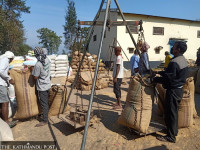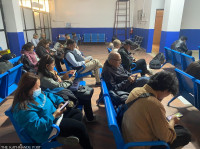Money
Price of yarsagumba surges after China re-opens border
Traders of Mugum Karmarong Rural Municipality in remote western Nepal have started selling the harvest gathered in May and June.
Raj Bahadur Shahi
The price of the Himalayan herb yarsagumba surged to a multi-year high immediately after the northern border with China, the main buyer, reopened after three years.
Traders say the valued fungus now fetches Rs2.8 million per kg.
The plant is prized in a number of countries, particularly China, for its purported aphrodisiac and healing properties. Nepali traders say that Chinese are the key buyers.
Yarsagumba, whose scientific name is Ophiocordyceps sinensis, is a small parasitic fungus that grows within a variety of caterpillars in the Himalayan region. It kills the caterpillar and emerges from the dead body as a thin stem.
Traders of Mugum Karmarong Rural Municipality in remote western Nepal have started selling the harvest gathered in May and June.
The fungus grows at elevations between 3,000 and 5,000 metres, and is harvested between May and June, right before the monsoon starts.
Tens of thousands of Nepali villagers flock to the Himalayan foothills in the 12 mountain districts in Nepal's mid- and far west to collect the fungus. They travel for days to the highlands and live there for up to two months in tents.
Chyangwa Tamang, ward chair of Mugum Karmarong Rural Municipality-2, said local traders procure the fungus from the villagers for Rs1.8 million per kg and sell it to Chinese buyers in Kathmandu for Rs2.8 million per kg.
According to locals, this year the traders paid them Rs600 to Rs1,000 per piece, depending on the size and quality of the fungus.
Before the pandemic, a piece would fetch Rs300 to Rs500. Local traders used to sell it for Rs1 million to Rs1.2 million per kg.
Around 3,000 pieces of yarsagumba are needed to make a kilogram.
“The price has doubled this year because of a low harvest,” said Tamang. "The Covid pandemic and closure of the Nepal-China border had prevented locals from collecting the expensive herb."
On May 1, the Chinese government re-opened the border point at Hilsa Pass in Nepal's northwest which had remained shut since the Covid-19 pandemic.
Beijing also permitted travellers to cross the Tatopani border point in the northeast of Kathmandu from September 1 after re-opening it to cargo traffic on May 1.
The Rasuwagadhi border point further west was re-opened to travellers on March 29.
Before the Covid pandemic, Chinese traders used to visit the Nakchenangla Pass in Mugu bordering Tibet to buy yarsagumba collected in Karnali.
Traders say the Chinese government is yet to re-open Nakchenangla Pass which was closed in 2020, although a number of border points have been re-opened.
Traders in Mugu say they sell the herb to Chinese buyers in Kathmandu.
“It was easier to sell yarsagumba when Nakchenangla Pass was open. We could negotiate with Chinese buyers,” said local trader Karma Tamang.
“Now we have to show permits, pay taxes in multiple provinces and suffer hassles at police checkpoints at several spots while transporting the herb to Kathmandu.”
The traders usually take yarsagumba to Nepalgunj by bus and from there to Kathmandu by air.
The highlands, locally known as patans, such as Sano Koiki, Thulo Koiki, Rimar and Takee, are the key areas were yarsagumba is collected.
Tshering Kyape Lama, ward chair of Mugum Karmarong Rural Municipality, said the local government collected Rs4.5 million in permit fees from yarsagumba collectors this fiscal year.
“This year, the permit fee per person was Rs1,000 for residents of Mugu and Rs3,000 for residents of neighbouring districts.”
According to Mugum Karmarong Rural Municipality, around 4,000 individuals collected yarsagumba in the highlands of Mugu.
Lama estimates that five members from every household in the village went to collect yarsagumba this year. He said that each family earned Rs300,000 to Rs400,000 this season.
Every summer when the snow melts and the grass begins to sprout, tens of thousands of people begin their seasonal journey to the high-altitude pastures in search of the valuable fungus, braving the cold weather and altitude sickness.
Roving groups of people, which include men, women and children, set up camps and spend months combing alpine ranges above 3,500 metres inch by inch for the caterpillar fungus. This cycle runs for almost a month before the monsoon arrives in mid-July.
Locals compare the seasonal activity to a "gold harvest", as thousands of people from the mountains make nearly 60 percent of their annual income by selling the collected fungus.
Until 2001, collecting yarsa was illegal. The government lifted the ban after the fungus started to become an income source for mountain communities, but imposed a royalty of Rs20,000 per kg.
The royalty has since increased to Rs30,000 per kg. The fee depends on the category of the collector—local, neighbour and other districts.
Demand for yarsa reportedly started to soar after the 1993 World Athletics Championship where Chinese athletes set new world records.




 10.12°C Kathmandu
10.12°C Kathmandu.jpg)













